
Zinc processing is the process of extracting zinc from its ores for use in different products. Because of the low melting point of 788 °F (420 °C), pure zinc applications are not many. However, alloyed forms have very many applications. For example, when 45{9aec2f3753136e72632b4743edb3bd445b461a73e7aee1730978bb7c413976bd} of zinc is added to copper, it forms bronze that has a very wide application, especially in the plumbing and food industry. This post outlines everything you need to know about zinc production and processing.
Zinc Mining and Concentration
Zinc is mined using different methods such as open-pit mining (for the case of oxidized ores) and underground mining methods (for the case of sulfide ores). The commonest method of underground extraction is cut-and-fill stoping. Then, the ore is concentrated before treatment.
The common method of concentration is isolating the sulfide minerals from impure constituents. In this process, the ore is crushed into small pieces that are then combined with water before further crushing in a ball mill. The result is a type of slurry that easily flows to the floatation tank/cells with chemical reagents. Then, the slurry reacts with the chemical reagent to form bubbles (froth) that contain zinc. This froth is skimmed to extract zinc.
Zinc Extraction and Refining
1. Roasting and sintering
The process of extracting zinc, electrolysis, and smelting, involves removal of sulfur using exothermic oxidation process. In the electrolysis production, the zinc concentrate is roasted in fluidized-bed roasters. The sulfur content can be reduced by up to 0.5{9aec2f3753136e72632b4743edb3bd445b461a73e7aee1730978bb7c413976bd}. Sulfur oxide generated in the process can be directed to a sulfuric acid plant.
2. Electrolysis
The electrolysis process involves a couple of steps. One, the preparation of the zinc sulfate by leaching zinc oxides calcines in sulfuric acid. Step two is purification that results in a zinc sulfate solution. The last step is electrolysis of the purified solution. The electrolysis refining process ensures that zinc reaches the purity of about 99.99{9aec2f3753136e72632b4743edb3bd445b461a73e7aee1730978bb7c413976bd}.
Zinc Metal and Associated Alloys
Though zinc can be used in its pure form, it is mainly mixed with other metals to form alloys that have better properties. About 50{9aec2f3753136e72632b4743edb3bd445b461a73e7aee1730978bb7c413976bd} of zinc is used for corrosion protection especially of steel and iron. Other uses of zinc include:
- Brass alloys.
- Cast zinc.
- Making of semiconductors.
- Die casting precision components.
- Construction materials.
Zinc is a very important metal because of its diverse applications. Though the production process might look complex, the advanced technology used by top brands such as Ural Mining Metallurgical Company (MMC) has made it relatively simple. This post has outlined the main zinc production process for producing pure and its alloys.

